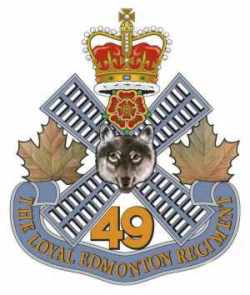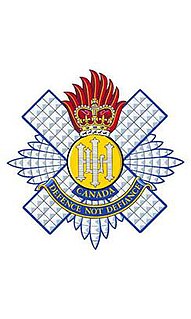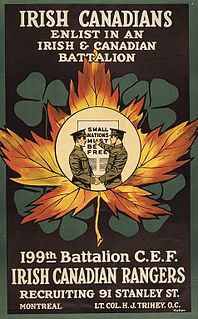
The Royal Regiment of Canada is a Primary Reserve infantry regiment of the Canadian Army based in Toronto, Ontario, part of 4th Canadian Division's 32 Canadian Brigade Group.

The Royal Hamilton Light Infantry (RHLI) is a Primary Reserve infantry regiment of the Canadian Army, based at John Weir Foote VC Armoury in Hamilton, Ontario. The RHLI is part of 31 Canadian Brigade Group, which is part of 4th Canadian Division.

The Nova Scotia Highlanders is a reserve infantry regiment of the Canadian Army. It is part of 36 Canadian Brigade Group, 5th Canadian Division.

The Toronto Scottish Regiment is a Primary Reserve infantry regiment of the Canadian Army. It is part of 4th Canadian Division's 32 Canadian Brigade Group.

The Loyal Edmonton Regiment, or LER, is a Primary Reserve infantry unit of the Canadian Forces based in Edmonton, Alberta. The LER is part of 3rd Canadian Division's 41 Canadian Brigade Group. They are colloquially known as "The Loyal Eddies".

The British Columbia Regiment is a Primary Reserve armoured reconnaissance (recce) regiment of the Canadian Army; the regiment is subordinate to 39 Canadian Brigade Group of the 3rd Canadian Division. Established in 1883, it is the oldest military unit in Vancouver, British Columbia, Canada. It parades at the Beatty Street Drill Hall at the corner of Dunsmuir and Beatty in Downtown Vancouver. The regiment has been variously designated as garrison artillery, rifles, infantry, and armoured, but has been reconnaissance since 1965. It has received 41 battle honours in its history, and has been a unit of the Royal Canadian Armoured Corps since 1942.

The Hastings and Prince Edward Regiment is a Primary Reserve infantry regiment of the Canadian Army. The regiment is part of 33 Canadian Brigade Group, one of four brigade groups of 4th Canadian Division. The regimental headquarters and one company are located at 187 Pinnacle Street in Belleville, with additional companies in Peterborough and Cobourg. The Peterborough Armoury houses what was traditionally "B Company" or "Moro Company", and "C Company" or "Cassino Company" is housed in an industrial mall unit on Willmott Street in Cobourg. Normally, the regiment deploys as a composite, Ortona Company, while the HQ/Admin forms Somme Company.

The Royal Highland Fusiliers of Canada is a Primary Reserve light infantry regiment of the Canadian Army, with companies in Cambridge and Kitchener, and is an infantry sub-unit of 31 Canadian Brigade Group, headquartered in London, Ontario. The Duke of York, as a member of the Canadian Royal Family, acts as Colonel-in-Chief. Previously, this post was held by The Princess Margaret, Countess of Snowdon.

The Brockville Rifles is a Primary Reserve infantry regiment of the Canadian Army. The unit is a part of the 33 Canadian Brigade Group, 4th Canadian Division. It is fifteenth in the order of precedence of Canadian Army Infantry Regiments.

The Essex and Kent Scottish is a Primary Reserve infantry regiment of the Canadian Forces.

The Canadian Scottish Regiment is a Primary Reserve infantry regiment of the Canadian Army based on Vancouver Island in British Columbia.
The 183rd Battalion, CEF was a unit in the Canadian Expeditionary Force during the First World War. Based in Winnipeg, Manitoba, the unit began recruiting during the winter of 1915/16 throughout the Province of Manitoba. After sailing to England in October 1916, the battalion was broken up in November 1916 and its men transferred to the following units: 100th Battalion, CEF, 107th Battalion, CEF, 108th Battalion, CEF, and the 144th Battalion, CEF. The 183rd Battalion, CEF had one Officer Commanding: Lieut-Col. W. T. Edgecombe.

The 133rd Battalion, CEF was a unit in the Canadian Expeditionary Force during the First World War.

The 199th Battalion, CEF was a unit in the Canadian Expeditionary Force (CEF) during the First World War.
The 226th Battalion, CEF was a unit in the Canadian Expeditionary Force during the First World War. Based in Dauphin, Manitoba, the unit began recruiting in March of 1916 in the area of Dauphin and Minnedosa, Manitoba. After sailing to England in December 1916, the battalion was absorbed into the 14th Reserve Battalion on April 7, 1917. The 226th Battalion, CEF had one Officer Commanding: Lieut-Col. R. A. Gillespie.

The 2nd Battalion, Irish Regiment of Canada is a Primary Reserve infantry regiment of the Canadian Army based in Sudbury, Ontario. It is part of the 4th Canadian Division's 33 Canadian Brigade Group.

Battalion Park is a geoglyph site in southwest Calgary, Alberta, Canada. It is located on Signal Hill, overlooking the Tsuu T'ina Nation, as well as lands formerly known as Camp Sarcee and later Sarcee Training Area, a military reserve used by the Canadian Forces from before the First World War up until the 1990s. The park extends over an area of 93 hectares, north of the Elbow River. Its heritage value is associated with its dedication to the heroic efforts of Albertan soldiers during the First World War. The site contains four geoglyphs, numbered 137, 113, 151, and 51. The large, whitewashed stones, totalling 16,000 in all, form the centrepiece of the park. Arranged on the side of the hill, and visible from various parts of the city, they represent the battalions numbered 137th, 113th, 151st, and 51st.
The 254th Battalion, CEF was a unit in the Canadian Expeditionary Force during the First World War. Based in Belleville, Ontario, the unit began recruiting in the autumn of 1916 in Hastings County. After sailing to England in June 1917, the battalion was absorbed into the 6th Reserve Battalion, CEF upon arrival. The 254th Battalion, CEF had one Officer Commanding: Lieut-Col. A. P. Allan.

The 46th Battalion, CEF, was an infantry battalion of the Canadian Expeditionary Force during the Great War. The 46th Battalion was authorized on 7 November 1914 and embarked for Britain on 23 October 1915. On 11 August 1916 it disembarked in France, where it fought with the 10th Infantry Brigade, 4th Canadian Division in France and Flanders until the end of the war. The battalion was disbanded on 30 August 1920.

The 84th Battalion, CEF was a battalion of the First World War Canadian Expeditionary Force. The battalion was authorized on 10 July 1915 and embarked for Great Britain on 18 June 1916. There, on 30 June 1916, its personnel were absorbed by the 73rd Battalion, CEF, 75th Battalion (Mississauga), CEF and other units of the 4th Canadian Division, to provide reinforcements for the Canadian Corps in the field. The battalion disbanded on 11 April 1918.

















